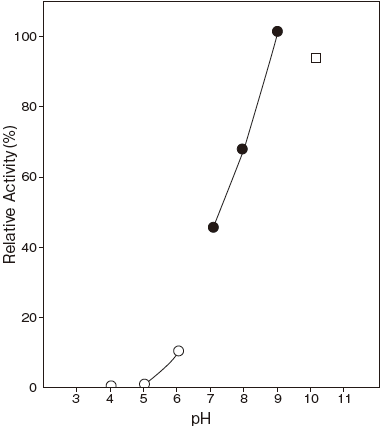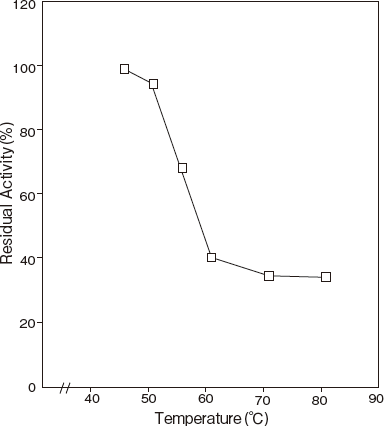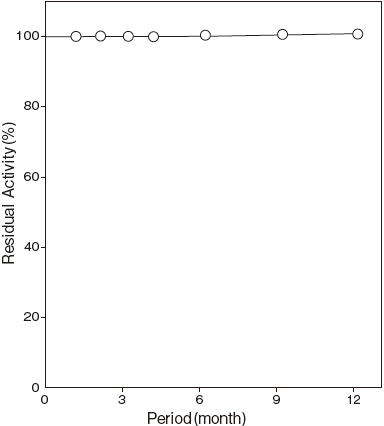ALKALINE PHOSPHATASE [ALP]
from Escherichia coli
(Orthophosphoric–monoester phosphohydrolase (alkaline optimum) , EC 3.1.3.1)
Orthophosphoric monoester + H2O Alcohol + H3PO4
Preparation and Specification
- Appearance
- : White amorphous powder, lyophilized
- Specific activity
- : More than 40 U/mg solid
Properties
- Molecular weight
- : 80 kDa (Sephadex G–200)
- Isoelectric point
- : pH 4.5
- Optimum pH
- : 9.0Figure 1
- pH stability
- : 8.5–10.0 (37℃, 60 min) Figure 2
- Thermal stability
- : Stable at 45℃ and below (pH 9.0, 10 min) Figure 3
- Storage stability
- : At least one year at−20℃Figure 4
- Activators
- : Na+, Mg 2+
Applications for Diagnostic Test
This enzyme is useful for enzymatic determination of lecithin when coupled with phospholipase C (T–11) and choline oxidase (T–05)
| PLC | ||
| Lecithin + H2O | → | Phosphorylcholine + Diglyceride |
| ALP | ||
| Phosphorylcholine + H2O | → | Choline + Pi |
| COD | ||
| Choline + 2 O2 + H2O | → | Betaine + 2 H2O2 |
| POD | ||
| 2 H2O2 + 4-AA + Phenol | → | Quinoneimine dye + 4 H2O |
Assay
Principle
-
The assay is based on the increase in absorbance at 420 nm as p –nitrophenol is liberated according to the following reaction:
| ALP | ||
| p–Nitrophenylphosphate+H2O | → | p–Nitrophenol+Orthophosphate |
Unit definition
-
One unit is defined as the amount of enzyme which liberates 1 μmole of p –nitrophenol per minute at 37℃ under the conditions specified in the assay procedure.
Reagents
- Reaction mixture
0.5 M Tris–HCl buffer pH 9.0 0.20 ml 10 mM p–nitrophenylphosphate solution 0.20 ml 4 M NaCl solution 1.00 ml Distilled water 0.50 ml - Reaction stopper
0.5 N NaOH solution - Enzyme dilution buffer
50 mM Tris–HCl buffer pH 9.0 - Reagents
p –nitrophenylphosphate (2Na・6H2O) :
FUJIFILM Wako Pure Chemical Corporation #149–02342
Enzyme solution
-
Accurately weigh about 20 mg of the sample and add enzyme dilution buffer to make a total of 20 ml.
Dilute it with enzyme dilution buffer to adjust the concentration as required.
Procedure
- Pipette accurately 1.90 ml of reaction mixture into a small test tube and preincubate at 37℃.
- After 5 min, add exactly 100 μl of enzyme solution and mix to start the reaction at 37℃.
-
※ In the case of a test blank, add 100 μl of enzyme dilution buffer in place of enzyme solution. - At 10 minutes after starting the reaction, add 1.0 ml of the reaction stopper to stop the reaction.
- Measure the absorbance at 420 nm.
△ A = (As−Ab) ≦ 0.50 AbsAbsorbance sample : As blank : Ab
Calculation
-
Activity (U/mg of powder) = {(△ A/10)/14.1} × 3.00/0.10 × 1/x
14.1 : millimolar extinction coefficient of p–nitrophenol at 420 nm (cm2/ μmole) 10 : reaction time (min) 3.00 : final volume (ml) 0.10 : volume of enzyme solution (ml) X : concentration of the sample in enzyme solution ( mg/ml)
Storage
-
Storage at –20℃ in the presence of a desiccant is recommended.
Enzyme activity will be retained for at least one year under this condition (Figure 4)
References
- Malamy, M. and Horecker, B.L (. 1966) Methods Enzymol., 9, 639.
- Rotman, F. and Byrne, R. (1963) J. Molec. Biol., 6, 330.
- Garen, A. and Levinthal, C. (1960) Biochim. Biophys.
Acta, 38, 470. - Heppel, L. A., Harkness, D. R. and Hilmoe, R. J. (1962) J. Biol. Chem., 237, 841.
- Dray F., Dith E. and Rougeot C. (1986) Method of
Enzymatic Analysis, Vol. 9, 348–362. - Rathman P. and Saxena B. B. (1986) Methods of
Enzymatic Analysis, Vol. 9, 396–404.
ALP 活性測定法 (Japanese)
試薬液
- 反応試薬混合液
0.5M トリス−HCl 緩衝液pH9.0 0.20 ml 10mM p – ニトロフェニルリン酸溶液 0.20 ml 4M NaCl 溶液 1.00 ml 精製水 0.50 ml - 反応停止液
0.5N NaOH 液 - 酵素溶解希釈用液
50mM トリス−HCl 緩衝液 pH9.0 - 試薬
p – ニトロフェニルリン酸・2Na・6H2O:
富士フイルム和光純薬製 特級 #149–02342
酵素試料液
- 検品約20mg を精密に量り、酵素溶解希釈用液に溶解して全容20ml とする。
その液を酵素溶解希釈用液で適宜希釈する。
測定操作法
- 小試験管に反応試薬混合液1.90ml を正確に分注して37℃で予備加温する。
- 5 分経過後、酵素試料液100 μl を正確に加えて混和し、37℃で反応を開始する。
※ 盲検は酵素試料液の代わりに酵素溶解希釈用液100μl を加える。 - 10 分経過後、反応停止液1.0ml を正確に加えて混和し、反応を停止する。
- 420nm における吸光度を測定する。
求められた吸光度を試料液はAs、盲検液はAb とする。
ΔA =(As−Ab) ≦ 0.50 Abs
計算
以下の計算式に従い、活性 (U/mg) を計算する。活性 (U/mg) = {(△ A/10)/14.1} × 3.00/0.10 × 1/x
| 14.1 : | p – ニトロフェノールの420nm におけるミリモル 分子吸光係数 (cm2/ μmole) |
| 10 : | 反応時間 (min) |
| 3.00 : | 反応総液量 (ml) |
| 0.10 : | 反応に供した酵素試料液量 (ml) |
| X : | 酵素試料液中の検品濃度 (mg/ml) |







